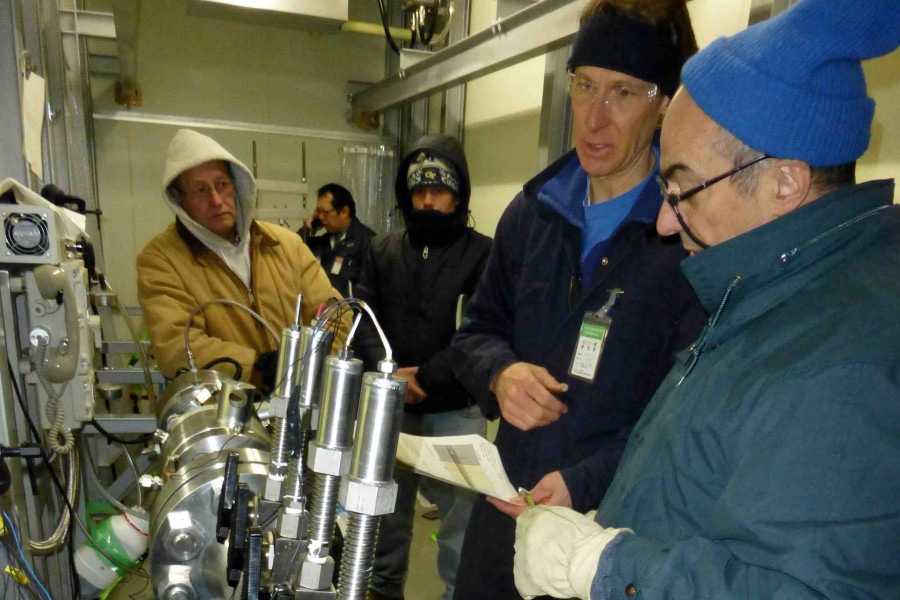
A new project in Japan is helping scientists from Georgia Tech and the U.S. Geological Survey (USGS) to study gas hydrates as a potential source for natural gas production.
“There may be more carbon trapped in methane hydrate than in all petroleum, coal and gas reserves in the world,” said CEE’s Dr. Carlos Santamarina, one of several scientists who traveled to Japan in January 2013 to conduct additional research.
“Our goal at Georgia Tech is to find ways to extract the methane, while at the same time trapping CO2 in the subsurface.”
 This research advances understanding of the global distribution of gas hydrates and explores whether and how methane contained in gas hydrates can be used as a viable energy source.
This research advances understanding of the global distribution of gas hydrates and explores whether and how methane contained in gas hydrates can be used as a viable energy source.
Gas hydrates are a naturally occurring, solid form of methane gas combined with water. They sequester large amounts of methane, making them a potentially significant source for natural gas around the world.
The collaboration continues a long-standing relationship between national methane hydrates research programs in Japan and the U.S., but represents the first time that U.S. researchers have been directly involved in studying Japanese gas hydrate samples. This collaborative research was funded by several organizations, including JOGMEC, MH21, AIST, USGS, DOE, and the multinational Gulf of Mexico Gas Hydrates JIP.
In the current phase of this project, an international group of scientists from Japan, the U.S. Geological Survey (USGS), and Georgia Tech are employing cutting-edge technology and studying rare gas hydrate samples recovered deep beneath the seafloor.
Although the results from the Japan trip will not be published for a couple of years, Dr. Santamarina has no doubt about the value of the two-week research venture. Furthermore, “this project has involved an amazing group of Georgia Tech Ph.D. students - Sheng Dai, Junbong Jang, Marco Terzariol and Efthymios Papadopoulos,” said Santamarina of the recent work his research group completed in Japan. “This research has exposed them to the most challenging energy problems, and stimulated them to develop unprecedented engineering solutions.”
 The U.S. and Japanese researchers analyzed the cores using specialized devices called Pressure Core Characterization Tools (PCCT), which were designed and built by the Georgia Tech team with long-term support from the U.S. Department of Energy (DOE) and the Gulf of Mexico Gas Hydrate Joint Industry Project (JIP).
The U.S. and Japanese researchers analyzed the cores using specialized devices called Pressure Core Characterization Tools (PCCT), which were designed and built by the Georgia Tech team with long-term support from the U.S. Department of Energy (DOE) and the Gulf of Mexico Gas Hydrate Joint Industry Project (JIP).
These devices allow scientists to study the cores while keeping them at their natural, stable conditions.
The first tool developed at Georgia Tech (the Instrumented Pressure Testing Chamber IPTC) was the first device capable of measuring physical properties of pressure cores without depressurizing them. During the Japan trip, USGS scientists operated the IPTC while the Georgia Tech team deployed a new set of pressure core characterization tools or PCCT devices to measure bioactivity, strength, compressibility, gas and water permeability, and sediment response during gas production.
The project is part of a multiyear, premier research program in deepwater gas hydrate exploration and production that is currently underway in Japan. The program is being led by the Japan Oil, Gas and Metals National Corporation (JOGMEC) and Japan’s National Institute of Advanced Industrial Science and Technology (AIST).
In 2012, Japanese researchers used innovative technology to retrieve and preserve sediment samples containing gas hydrates. These samples obtained from layers beneath the deep seafloor in the Nankai Trough offshore Japan were tested during the recent deployment in Japan.
Such well-preserved samples are extremely rare. They are preserved as “pressure cores,” with the gas hydrates kept as if they were still at the natural conditions in the subsurface where they formed. Gas hydrates are only stable at certain pressures and temperatures, and the Georgia Tech team has been working since the early 2000s to develop unprecedented technology to preserve and characterize these cores without causing dissociation.
Testing the PCCT instruments in Japan will help prepare for the analysis of pressure cores that may be obtained in the future from hydrate deposits in the deepwater Gulf of Mexico and on the Alaskan North Slope. Along with Japan, these areas are likely locations for future research to assess the occurrence and production potential of gas hydrates.
 The pressure core characterization tools and an IPTC manufactured by AIST are also used to conduct laboratory production tests on the pressure cores. During these tests, cores are depressurized at closely controlled rates to breakdown the methane hydrate and release natural gas. By measuring the sediment response, the volume of gas produced and the rate of production, insight is gained regarding the potential behavior of the reservoirs during the planned field test. Mini-production tests and future full-scale field production tests are a required step to potentially realize gas hydrates as an energy resource.
The pressure core characterization tools and an IPTC manufactured by AIST are also used to conduct laboratory production tests on the pressure cores. During these tests, cores are depressurized at closely controlled rates to breakdown the methane hydrate and release natural gas. By measuring the sediment response, the volume of gas produced and the rate of production, insight is gained regarding the potential behavior of the reservoirs during the planned field test. Mini-production tests and future full-scale field production tests are a required step to potentially realize gas hydrates as an energy resource.
Japanese researchers will also be conducting the first offshore production test to track how much methane can be released from deepwater gas hydrate deposits. Focus will be in the Nankai Trough, which is where the cores being studied now were recovered.
